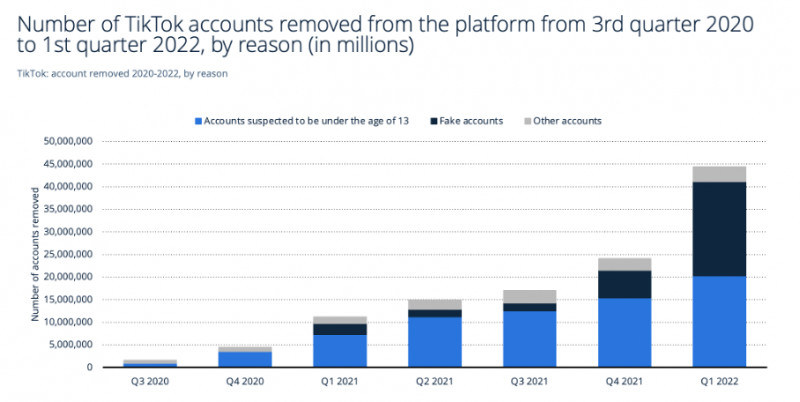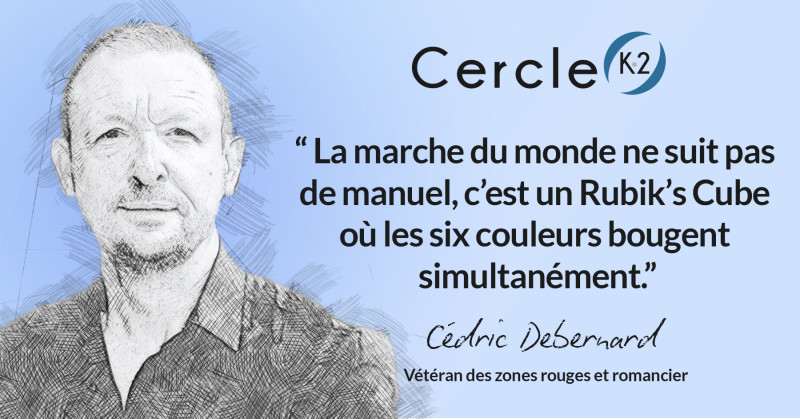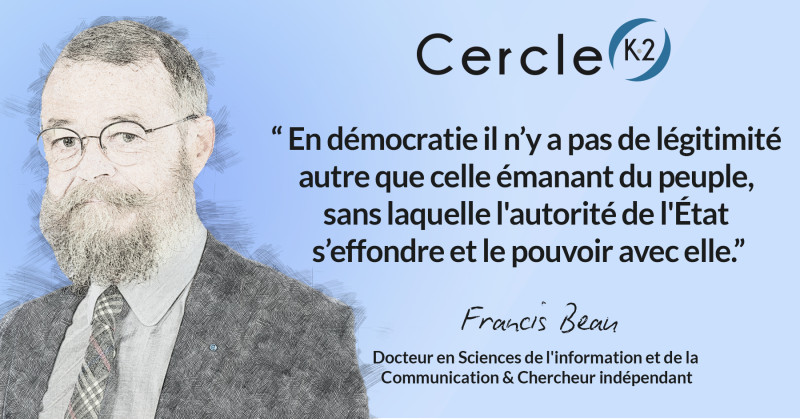[Groupe K2] Data et Key Opinion Leader : a pivot of new world influence [English version]
16/12/2022 - 8 min. de lecture
![[Groupe K2] Data et Key Opinion Leader : a pivot of new world influence [English version] - Cercle K2](https://cercle-k2.fr/storage/4316/conversions/jun-zhou-data-group-k2-en-large.jpg)
Cercle K2 neither approves or disapproves of the opinions expressed in the articles. Their authors are exclusively responsible for their content.
Jun Zhou is Entrepreneur, Lecturer & Consultant in Chinese Social Media.
---
From the e-commerce economy to politics, KOL has been a critical role in digital influence transmission yet such tool can also be a double-edged sword depending on who is the one swinging it.
What is KOL?
KOL is short for Key Opinion Leader, someone who is demonstrated as a trustworthy and well-respected digital influencer. This word is commonly used in social media marketing, describing a type of e-commerce marketing method embedded on social media. The concept of Opinion Leader comes from the theory of “Two-step flow of communication”, which was first introduced by sociologist Paul Lazarsfeld in 1944. Sociologist and communication scientist Elihu Katz who elaborated the theory of “Two-step flow of communication” later illustrated that the Opinion Leader being influential is related” (1) to the personification of certain values (who one is); (2) to competence (what one knows); and (3) to strategic social location (whom one knows)” [1].
The KOL usually work in their specialized field and on social media, and they share knowledge or tips based on their specialties. Consumers listen to KOL because they represent authority and credibility in their field. Some might argue about the difference between KOL and influencer, however, the key concept behind them is the same – influence. In Merriam-Webster’s dictionary, influence [2] is defined as “the power or capacity of causing an effect in indirect or intangible ways; the act or power of producing an effect without apparent exertion of force or direct exercise of command; corrupt interference with authority for personal gain”. One common indicator (not always reliable) to measure the influence of a KOL or influencer is the number of followers. A follower on social media is someone who subscribes to the feed of other accounts to follow the updates. Based on the number of followers, they are categorized into five types: Nano-KOL (1K-5K), Micro-KOL (5K-20K), Mid-KOL (20K-100K), Macro-KOL (100K-1M), and Mega-KOL (over 1M). With these categories, the average price to cost per post ranges exponentially different. Take Instagram for example, in 2020 worldwide the minimum price per post for Nano ones is around 10 dollars, for Mid ones is around 30 dollars, however for Macro and Mega KOL, the prices per post are 160 dollars and 1k dollars respectively. Be in mind that on different social media platforms, because of the difference in production complexity, the price per post with the same type of KOL with a similar number of followers varies. On Youtube, in 2020 worldwide the price overall per post(video) is more expensive than on Instagram, going from 60 dollars for Nano-KOL to 7k dollars for Mega-KOL.


(Source : Statista_Influencer Marketing)
What important role has KOL played?
KOL is developed along with the social media network and nowadays plays a critical role in people’s decision-making in e-commerce. According to Statista, social media accounts for 33% as the second top leading source worldwide of online-shopping inspiration in 2021. In 2021 the market size worldwide of KOL has tripled its value to 13.8 billion dollars from 2018. This year, KOL marketing penetration in the US is expected to be 73%. China is by far the largest e-commerce market in the world with a revenue of 1.5 trillion dollars (worldwide is 4.9 trillion dollars) and KOL marketing has ranked the top choice for Chinese internet users to discover brands, beating out search engines, and brand websites, and consumer review sites.
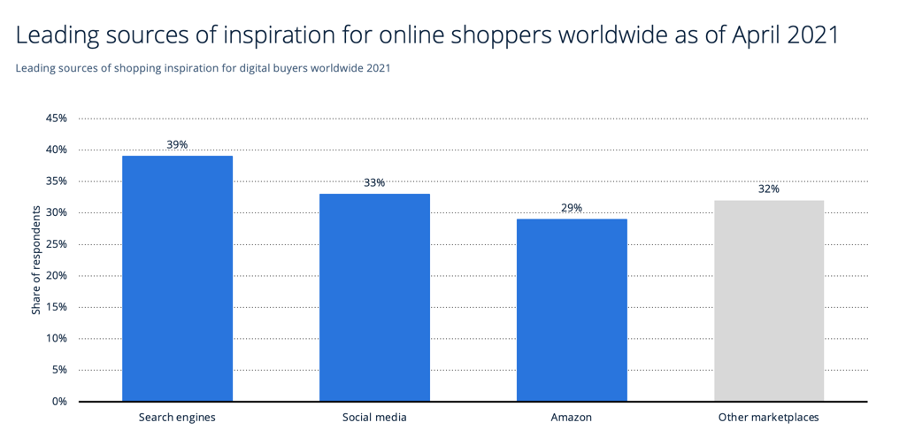
(Source : Statista E-commerce dans le monde)
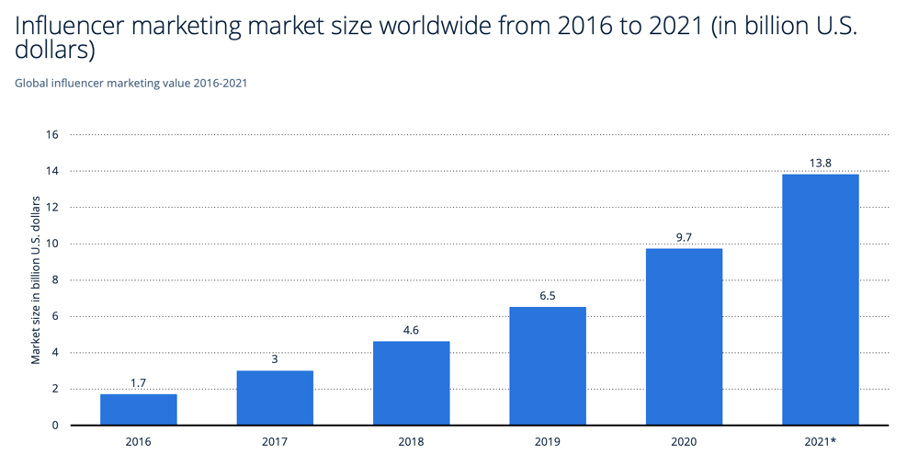
(Source : Statista Influencer Marketing)
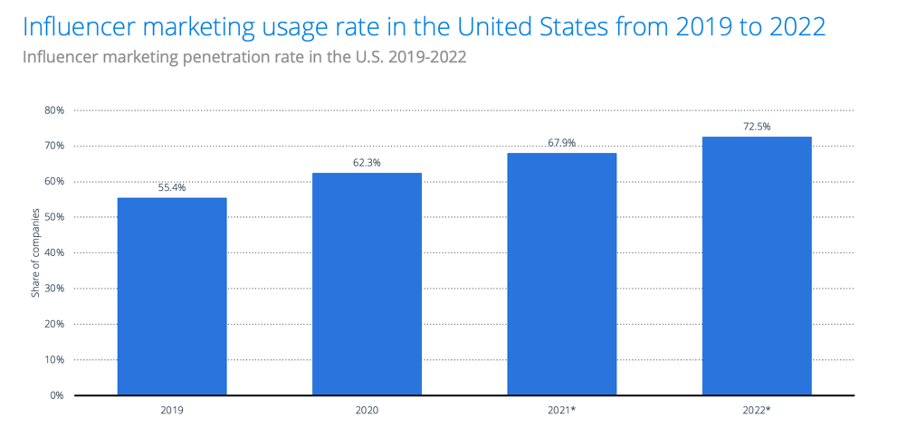
(Source : taux de pénétration du marketing Statista Influencer aux États-Unis)
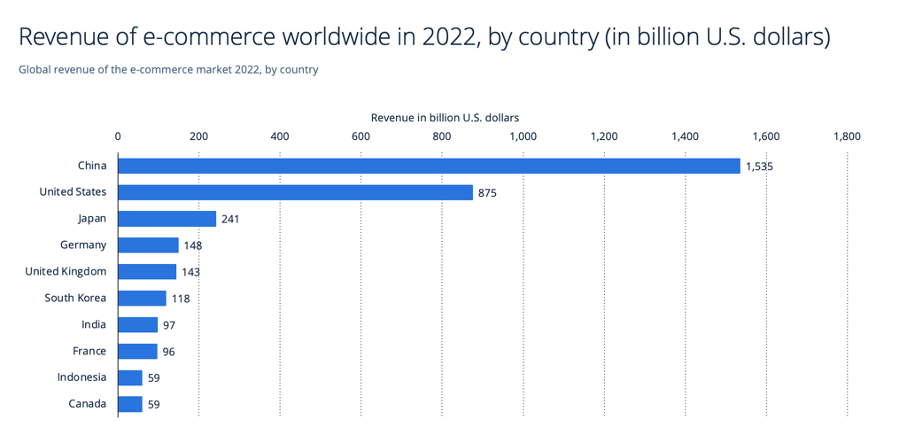
(Source : Statista E-commerce en Chine)
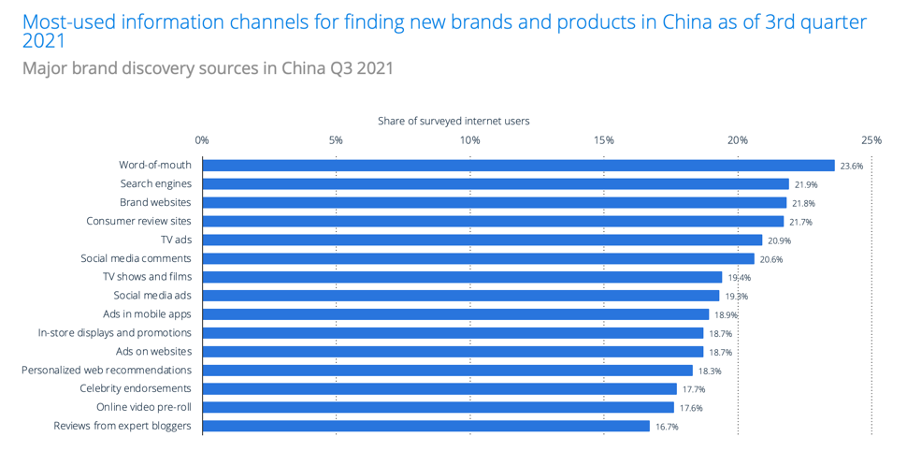
(Source : Statista Sources de découverte de marque en Chine Q3 2021)
Starting from the Web2.0 era, the new way of communicating with blogs and social networks shapes the engagement between readers/users and content creators, brings people closer, and breaks the geography barrier. Social media enables individuals to share their opinions in a more free and less controlled and supervised environment than traditional media. The influence of KOL on social media not only sparks its key role in the e-commerce economy but also in other aspects such as politics.
Following the concept of influence, the political KOL surely imposes a radical impact on the world. Former U.S. President Barack Obama is probably one of the earliest political KOL adopters. Starting his Twitter account in 2007, by 2008 he was most followed in the world [3]. During the campaign period, Obama used over 15 social network sites. He was the very first Presidential candidate to leverage such a powerful method to frequently update his daily activities and communicate with his supporters for fundraising and campaigns. This social media KOL identity allows him to reach out to younger generations to vote. After Barack Obama, Donald Trump is another famous political KOL who had made his social media influence to another level. Before the election, many people know Donald Trump for his famous TV series “The Apprentice” which started in 2004 and ended in 2017. He was the host for fourteen seasons before running for the presidency. Trump was the first U.S. President with neither prior military nor government service experience. With no doubt, he knew greatly how media and influence work. He joined Twitter in 2009, had 88.7 million followers, and posted around 57,000 tweets in total [4]. After a shocking day in American history – the storming of the United States Capitol, Trump got banned from Twitter, Facebook, and other social media platforms. Such ban reflects the world how destructive online influence can be.
Pros VS. Cons
The pros and cons of KOL communication are about how to leverage the pros and cons of social media as a tool for influence transmission.
Pros – a new way of passing influence, radical and borderless.
Traditional media offers one-way communication whereas social media offers two-way communication and it is faster and more radical with the simple click functions of sharing and reposting. Although it is hard to find a unanimous way to measure the influence given to the mechanism differences for shares and views on different social media platforms, it is still more cost-effective to pass influence on social media than on traditional media. In the social media network, the easiness of spreading the information from one user to another allows for a faster chain effect of influence. Thus, KOL with any background easily connects people very quickly with a wide audience and the synergy creates a movement of massive like-minded people. The impact is radical and also borderless. Imagine thousands of years ago, if Plato wants to pass his thoughts from west to east, it would have taken decades and decades for thousands of messengers to cross countries and regions. Now one letter takes around one week to two weeks to travel from France to China. However, a professor who is well-connected within the social media networks can send out a post anywhere anytime and within one blink all the followers from any corner of the world could have seen it. This social media network makes the world flatter and more seamless, enabling KOL to spread its influence not just locally but globally.
Cons – an easy method for manipulation
The influence transmission on social media is too powerful. Just like everything has two sides. It is also destructive for KOL to leverage their influence to spread false information, mislead the followers and manipulate the audience.
For an apple, if few people say it’s black, you probably think they are crazy. What if thousands, ten thousand, hundreds of thousands of people say it’s white? What’s your answer? Many people would think it’s obvious it’s red and they won’t agree on the answer either white or black. However, an actual experiment carried out in the 1950s showed us otherwise. This is the famous Asch Conformity Experiment [5]. In the experiment, psychologist Solomon Asch asked people to select the line that matched the one from a group of three lines. Asch also placed people to purposely select the wrong ones. The result revealed that when other people picked the wrong one, the participants were likely to conform and choose the same as the rest of the group. This experiment demonstrated that people think they can resist group pressure especially when they know the group is wrong, actually surprisingly they are susceptible to conformity and would take the wrong answers in order to fit in the group. Now we have to ask ourselves the following question: for the information that has been shared thousands and thousands of times online, do we believe it or not? Do we believe it because many people say so? Or do we believe it because it comes from someone who is portrayed as powerful, influential, and well-known – someone who is KOL?
Future KOL
The key driver behind influence can be summarized as the will to change how people think and act. It can be for monetary purposes, knowledge-sharing purposes, or the purpose of information control. Surely more and more people from various backgrounds will try to be KOL and use their influence to serve those purposes. In the past ten years, we can clearly see the increasing number of celebrities, politicians, businessmen, and many other people with different professions becoming KOLs. The competition to fight for the audience’s attention and maintain dominance will become fiercer than ever. The question is: are we living in a “post-truth” world [6]? Oxford dictionary has defined the “post-truth” [7] as “relating to or denoting circumstances in which objective facts are less influential in shaping public opinion than appeals to emotion and personal belief”. One of the key tactics for social media content creation is to create emotional resonance with the audience/followers. There is only one thin line between the two intentions behind - genuine connection and manipulation.
In the current Web 4.0 era, data are given to meaning that Artificial Intelligence and Machine Learning have merged into our daily life for collective innovation and intelligence. Yet, these technologies have also been used in social media platforms for constructing opinions in the desired direction under the echo chamber effect. It is absolutely possible to make a fake KOL bot account and millions of fake followers. Take TikTok for example, in the first quarter of 2022, fake accounts account for over half of the total accounts that got removed. So, how do you even know the account you follow is the real person behind it and not a persona? The virtual KOL who is a digital character created through graphic software and run by a company is no new to the social media world. The virtual KOL concept can be easily stretched to a persona whom people can’t identify if they are real or what the intention is behind it.
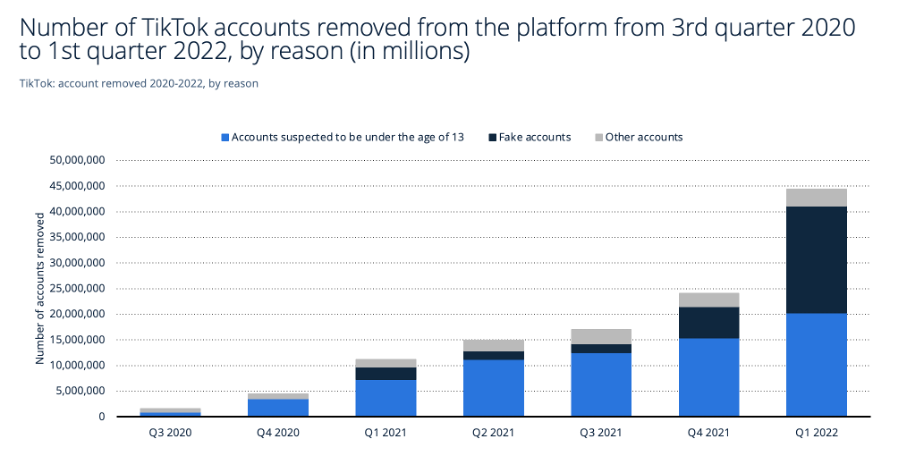
Three times Pulitzer Prize winner Thomas L. Friedman in his book “The World Is Flat: A Brief History of the Twenty-First Century” introduced the idea of “horizontalization” - “We are going from a world where value was created almost exclusively in command-and-control silos, from the top down, to a world where value is going to increasingly be created by connect-and-collaborate, horizontally. We are going from a vertical value-creation model to a horizontal value-creation model.” The vertically organized society can be also seen as a pyramid of “Power relations of oppression and resistance” [8], in short, the capital and power run the show, whereas the horizontally organized society is more seen as a collection of diverse groups such as associations, organizations, and advocacies formed due to various cultural, religious, ethical-racial and ideological backgrounds. Other than the increasing numbers of individual KOL, will there be more KOL representing such groups?
To address future KOL, a few questions we shall ask ourselves: Firstly, as readers and users of social media networks, how can we make our own judgments with the massive information fed through KOL? In addition, how can we encourage more responsible KOLs and leverage their influence? Last but not least, who shall play the role to regulate any conduct on social media networks and how?
---
Bibliography
[1] E. Katz, "The Two-Step Flow of Communication: An Up-To-Date Report on an Hypothesis," Political Opinion Quarterly, vol. 21, no. 1, pp. 61-78, 1957.
[2] "merriam-webster," [Online]. Available: https://www.merriam-webster.com/dictionary/influence.
[3] J. Han, Networked Information Technologies, Elections, and Politics: Korea and the United States, Lexington Books, 2011.
[4] A. MADHANI and J. COLVIN, "A farewell to @realDonaldTrump, gone after 57,000 tweets," 9 January 2021. [Online]. Available: https://apnews.com/article/twitter-donald-trump-ban-cea450b1f12f4ceb8984972a120018d5
[5] K. Cherry, "The Most Famous Social Psychology Experiments Ever Performed," 14 December 2020. [Online]. Available: https://www.verywellmind.com/famous-social-psychology-experiments-2795667.
[6] H. McQuilkin and M. Chakrabarti, "Part IV: Are We Living In A Post-Truth World?," 27 February 2020. [Online]. Available: https://www.wbur.org/onpoint/2020/02/27/part-iv-post-truth.
[7] "Word of the Year 2016," Oxford University Press, [Online]. Available: https://languages.oup.com/word-of-the-year/2016/.
[8] M. A. Martínez, "Vertical and horizontal relations: What is ‘society’ about?," 28 May 2018. [Online]. Available: https://www.miguelangelmartinez.net/?Vertical-and-horizontal-relations-What-is-society-about.
[9] N. PAPPAS, "Socrates, Cynics and Flat-Nailed, Featherless Bipeds," 4 April 2016. [Online]. Available: https://archive.nytimes.com/opinionator.blogs.nytimes.com/2016/04/04/of-socrates-cynics-and-flat-nailed-featherless-bipeds/.
[10] W. D. United States Holocaust Memorial Museum, ""FINAL SOLUTION": OVERVIEW," 8 December 2020. [Online]. Available: https://encyclopedia.ushmm.org/content/en/article/final-solution-overview.
[11] W. D. United States Holocaust Memorial Museum, "EICHMANN TRIAL," 16 July 2021. [Online]. Available: https://encyclopedia.ushmm.org/content/en/article/eichmann-trial.
---
This post is part of the Groupe K2 "Enjeux du Big Data" composed of :
Kevin Dumoux est Co-créateur du Cercle K2, Conseil en Stratégie, Transformations digitales et M&A - Messaoud Chibane (PhD) est Directeur du MSc Finance & Big Data, NEOMA Business School, Lauréat du Trophée K2 "Finances" 2018 - Shirine Benhenda (PhD) est Experte en Biologie moléculaire, données OMICS - Sonia Dahech est Directrice CRM, Trafic et Data omnicanal chez BUT - Franck DeCloquement est Expert en intelligence stratégique, Enseignant à l'IRIS et l'IHEDN, Spécialiste Cyber - Franck Duval est Administrateur des Finances publiques, Directeur adjoint du pôle gestion fiscale, DDFiP 92 - Yara Furlan est Trader Social Media chez Publicis Media - Jean-Baptiste Harry est HPC & AI Solution Architect & pre sales EMEA chez NEC Europe - Timothé Hervé est Risk Manager à la Banque de France - Aurélie Luttrin est Président, Eokosmo - Yann Levy est Data Analyst, Expert BI - François Marchessaux est Senior Partner, Franz Partners - Conseil en Stratégie & Management - Aurélie Sale est Coach Agile chez Renault Digital - Jun Zhou est Entrepreneur, Lecturer & Consultant in Chinese Social Media
---
DOWNLOAD THIS REPORT (in French)
16/12/2022









